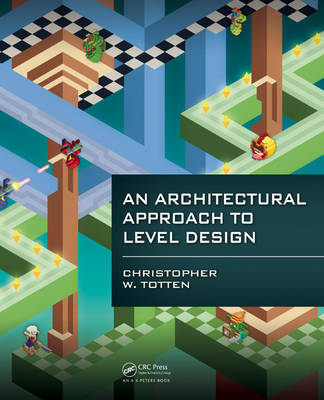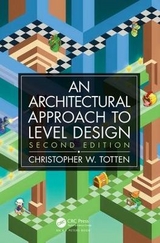
An Architectural Approach to Level Design
A K Peters (Verlag)
978-1-4665-8541-6 (ISBN)
- Titel erscheint in neuer Auflage
- Artikel merken
Written by a game developer and professor trained in architecture, An Architectural Approach to Level Design is one of the first books to integrate architectural and spatial design theory with the field of level design. It explores the principles of level design through the context and history of architecture, providing information useful to both academics and game development professionals.
Understand Spatial Design Principles for Game Levels in 2D, 3D, and Multiplayer Applications
The book presents architectural techniques and theories for level designers to use in their own work. The author connects architecture and level design in different ways that address the practical elements of how designers construct space and the experiential elements of how and why humans interact with this space. Throughout the text, readers learn skills for spatial layout, evoking emotion through gamespaces, and creating better levels through architectural theory.
Create Meaningful User Experiences in Your Games
Bringing together topics in game design and architecture, this book helps designers create better spaces for their games. Software independent, the book discusses tools and techniques that designers can use in crafting their interactive worlds.
Christopher Totten is an assistant professor of game design at George Mason University with a master’s degree in architecture from the Catholic University of America. He recently founded an indie game studio, Pie for Breakfast Studios, and has previously worked on several indie mobile and serious game projects as an artist, art director, animator, level designer, and producer. He has written articles for Gamasutra, VideoGameWriters, and GameCareerGuide as well as the book Game Character Creation with Blender and Unity. He is a steering committee member for the IGDA Washington, D.C. chapter and has been featured at GDC China, East Coast Game Conference, DiGRA, and other industry events.
A Brief History of Architecture and Level Design
Breaking the Rules of Level Design
An Experiential History of Architecture
The History of Gamespaces
Ways of Seeing for Level Design
Tools and Techniques for Level Design
Level Design Goals for Creating Game Experiences
Non-Digital Level Design Tools
Digital Level Design Tools
Level Design Workflows
Engine-Specific Methodologies
Basic Gamespaces
Architectural Spatial Arrangements
Historic Gamespace Structures
Spatial Size Types
Molecule Level Spaces
Form Follows Gameplay with Proximity Diagrams
Hub Spaces
Sandbox Gamespaces
Considerations of Camera
Enemies as Alternative Architecture
Teaching in Levels through Visual Communication
Teaching Theories for Game Levels
Symbols and Visual Design in Games
Architectural Forms and Types
Teaching Gameplay through Advertising Methods
Controlling Information in Memory Palaces
Introducing Emotional Level Design through Survival Instincts
Survival Instincts and Player Avatars
Prospect and Refuge Spatial Design
Shade, Shadow, and Survival
Loving and Hating Height
Conclusion
Enticing Players with Reward Spaces
The Purpose of Rewards
The Types of Rewards in Gamespaces
Making Rewards Exciting through Denial
Goals and Reward Schedules
Storytelling in Gamespace
Expressive Design
Mechanics vs. Motif
Narrative Spaces
Environment Art Storytelling
Materiality and the Hero’s Journey
Pacing and Narrative Rewards
Possibility Spaces and Worldbuilding
Understanding Immersion and Player Individuality
Architectural Phenomenology and Play
Emergent Spaces
Miniature Garden Aesthetic
Japanese Garden Design and Worldbuilding
Offering Experiential Choice
Degenerative Design
Influencing Social Interaction with Level Design
Emergence and Social Interaction
Learning from Urban Emergence
The Importance of Spawn Points and Quest Hubs
Houses, Homes, and Hometowns in Games
Enhancing Level Design with Music and Sounds
The Role of Rhythm in Games and Buildings
Complementing Level Design with Ambient Sound
Enhancing Gameplay Experiences with Sound Design
Real-World Adaptive Level Design
When Magic Circles Collide
Adaptive Game Reuse Goals
Analysis for Adaptive Core Mechanics
A Summary and Endnotes appear at the end of each chapter.
| Erscheint lt. Verlag | 20.8.2014 |
|---|---|
| Zusatzinfo | 2 page color insert follows page 160; 2 Tables, black and white; 4 Illustrations, color; 305 Illustrations, black and white |
| Verlagsort | Natick |
| Sprache | englisch |
| Maße | 156 x 234 mm |
| Gewicht | 658 g |
| Themenwelt | Informatik ► Grafik / Design ► Film- / Video-Bearbeitung |
| Informatik ► Software Entwicklung ► Spieleprogrammierung | |
| ISBN-10 | 1-4665-8541-2 / 1466585412 |
| ISBN-13 | 978-1-4665-8541-6 / 9781466585416 |
| Zustand | Neuware |
| Informationen gemäß Produktsicherheitsverordnung (GPSR) | |
| Haben Sie eine Frage zum Produkt? |
aus dem Bereich



